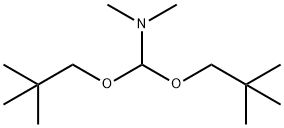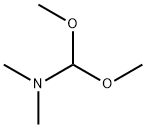N,N-DIMETHYLFORMAMIDE DINEOPENTYL ACETAL
Synonym(s):1,1-Dineopentyloxy-N,N-dimethylmethylamine;1,1-Dineopentyloxytrimethylamine
- CAS NO.:4909-78-8
- Empirical Formula: C13H29NO2
- Molecular Weight: 231.37
- MDL number: MFCD00008851
- EINECS: 225-536-4
- SAFETY DATA SHEET (SDS)
- Update Date: 2024-11-21 15:02:05

What is N,N-DIMETHYLFORMAMIDE DINEOPENTYL ACETAL?
Chemical properties
Colorless to slight yellow liquid
The Uses of N,N-DIMETHYLFORMAMIDE DINEOPENTYL ACETAL
N,N-Dimethylformamide dineopentyl acetal helps in the lactonization of ω-hydroxyacids, giving lactones of up to 16-membered rings. It can be used to convert primary alcohols to alkylating agents for use in the alkylation of thiols. It is used in the esterification of Nα-9-fluorenylmethyloxycarbonylamino acids. It was used in the synthesis of 1,3-dialkyl, benzyl and cyclohexyl barbiturate derivatives. It was used as reagent during the synthesis of L-serine and L-cystine stereospecifically labeled with deuterium at the β-position.
Properties of N,N-DIMETHYLFORMAMIDE DINEOPENTYL ACETAL
| Melting point: | 253.5℃ |
| Boiling point: | 85-87 °C/10 mmHg (lit.) |
| Density | 0.829 g/mL at 25 °C (lit.) |
| refractive index | n |
| Flash point: | 125 °F |
| storage temp. | Store at 0-5°C |
| form | clear liquid |
| pka | 5.24±0.50(Predicted) |
| color | Colorless to Almost colorless |
| Water Solubility | Hydrolyzes with water. |
| Sensitive | Moisture Sensitive |
| BRN | 741992 |
| CAS DataBase Reference | 4909-78-8(CAS DataBase Reference) |
Safety information for N,N-DIMETHYLFORMAMIDE DINEOPENTYL ACETAL
| Signal word | Warning |
| Pictogram(s) |
 Flame Flammables GHS02  Exclamation Mark Irritant GHS07 |
| GHS Hazard Statements |
H226:Flammable liquids H315:Skin corrosion/irritation H319:Serious eye damage/eye irritation H335:Specific target organ toxicity, single exposure;Respiratory tract irritation |
| Precautionary Statement Codes |
P210:Keep away from heat/sparks/open flames/hot surfaces. — No smoking. P233:Keep container tightly closed. P240:Ground/bond container and receiving equipment. P241:Use explosion-proof electrical/ventilating/lighting/…/equipment. P303+P361+P353:IF ON SKIN (or hair): Remove/Take off Immediately all contaminated clothing. Rinse SKIN with water/shower. P305+P351+P338:IF IN EYES: Rinse cautiously with water for several minutes. Remove contact lenses, if present and easy to do. Continuerinsing. |
Computed Descriptors for N,N-DIMETHYLFORMAMIDE DINEOPENTYL ACETAL
New Products
Tert-butyl bis(2-chloroethyl)carbamate 4-Methylphenylacetic acid N-Boc-D-alaninol N-BOC-D/L-ALANINOL 3-Morpholino-1-(4-nitrophenyl)-5,6-dihydropyridin- 2(1H)-one Furan-2,5-Dicarboxylic Acid Tropic acid 1,1’-CARBONYLDIIMIDAZOLE DIETHYL AMINOMALONATE HYDROCHLORIDE R-2-BENZYLOXY PROPIONIC ACID 1,1’-CARBONYLDI (1,2-4 TRIAZOLE) N-METHYL INDAZOLE-3-CARBOXYLIC ACID (2-Hydroxyphenyl)acetonitrile 4-Bromopyrazole 5-BROMO-2CYANO PYRIDINE 5,6-Dimethoxyindanone 5-broMo-2-chloro-N-cyclopentylpyriMidin-4-aMine 2-(Cyanocyclohexyl)acetic acid 4-methoxy-3,5-dinitropyridine 2-aminopropyl benzoate hydrochloride 1-(4-(aminomethyl)benzyl)urea hydrochloride diethyl 2-(2-((tertbutoxycarbonyl)amino) ethyl)malonate tert-butyl 4- (ureidomethyl)benzylcarbamate Ethyl-2-chloro((4-methoxyphenyl)hydrazono)acetateRelated products of tetrahydrofuran







You may like
-
 N,N-Dimethylformamide dineopentyl acetal CAS 4909-78-8View Details
N,N-Dimethylformamide dineopentyl acetal CAS 4909-78-8View Details
4909-78-8 -
 N,N-Dimethylformamide dineopentyl acetal 95% CAS 4909-78-8View Details
N,N-Dimethylformamide dineopentyl acetal 95% CAS 4909-78-8View Details
4909-78-8 -
![N,N-Dimethylformamide Dineopentyl Acetal [for Esterification] CAS 4909-78-8](https://img.chemicalbook.in//Content/image/CP5.jpg) N,N-Dimethylformamide Dineopentyl Acetal [for Esterification] CAS 4909-78-8View Details
N,N-Dimethylformamide Dineopentyl Acetal [for Esterification] CAS 4909-78-8View Details
4909-78-8 -
 N,N-Dimethylformamide dineopentyl acetal CAS 4909-78-8View Details
N,N-Dimethylformamide dineopentyl acetal CAS 4909-78-8View Details
4909-78-8 -
 1975-50-4 98%View Details
1975-50-4 98%View Details
1975-50-4 -
 14714-50-2 (2-Hydroxyphenyl)acetonitrile 98+View Details
14714-50-2 (2-Hydroxyphenyl)acetonitrile 98+View Details
14714-50-2 -
 118753-70-1 98+View Details
118753-70-1 98+View Details
118753-70-1 -
 733039-20-8 5-broMo-2-chloro-N-cyclopentylpyriMidin-4-aMine 98+View Details
733039-20-8 5-broMo-2-chloro-N-cyclopentylpyriMidin-4-aMine 98+View Details
733039-20-8
Statement: All products displayed on this website are only used for non medical purposes such as industrial applications or scientific research, and cannot be used for clinical diagnosis or treatment of humans or animals. They are not medicinal or edible.